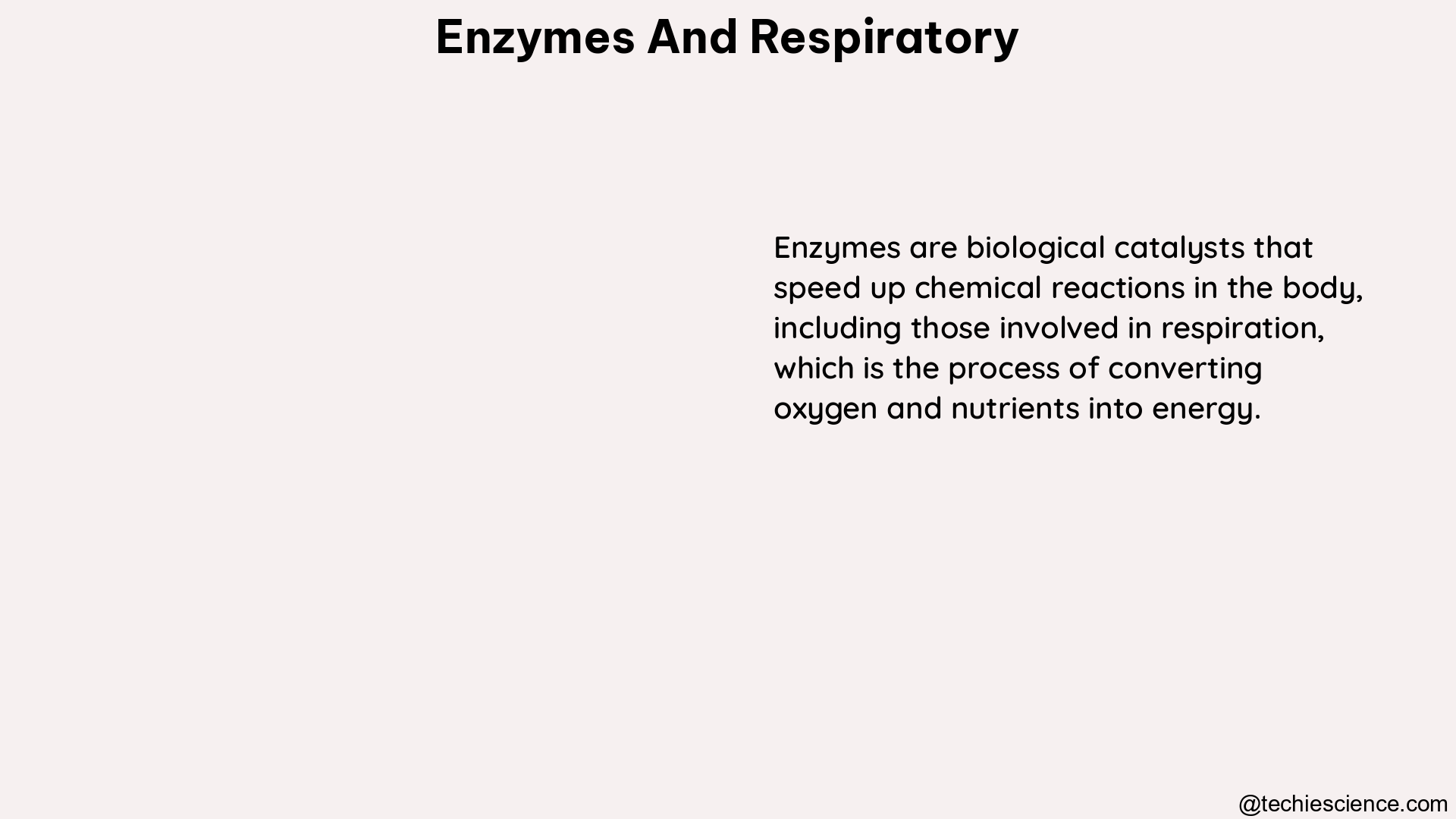Enzymes and respiratory processes are fundamental to the survival and functioning of all living organisms. Enzymes act as catalysts, accelerating chemical reactions, while respiration is the process by which cells convert the energy stored in organic molecules into a form that can be used by the cell, known as ATP. This comprehensive guide will delve into the intricate relationship between enzymes and respiratory processes, providing a detailed exploration of the various techniques used to measure and quantify their activities.
Enzymes in the Electron Transport Chain
The electron transport chain (ETC) is a crucial component of the respiratory process, responsible for the generation of the proton gradient that drives the production of ATP. Enzymes play a vital role in this process, acting as catalysts to facilitate the transfer of electrons through a series of complexes.
The ETC is composed of four main complexes: Complex I (NADH dehydrogenase), Complex II (succinate dehydrogenase), Complex III (cytochrome bc1 complex), and Complex IV (cytochrome c oxidase). Each of these complexes contains multiple enzymes that work together to transfer electrons and generate the proton gradient.
Measuring Respiratory Chain Enzyme Activity (RCEA)
One technique used to assess the activity of these enzymes is the measurement of respiratory chain enzyme activity (RCEA) in human renal biopsy specimens. This method, as described in a study published in the Journal of the American Society of Nephrology, involves measuring the activities of Complexes I, II/III, and IV of the ETC, expressed as a ratio of citrate synthase activity.
The study found a range of RCEA values for each complex:
– Complex I: 0.161 to 0.866
– Complex II/III: 0.021 to 0.318
– Complex IV: 0.001 to 0.025
These data provide a baseline for assessing mitochondrial function in kidney tissue and can aid in the diagnosis of mitochondrial disorders, which often involve defects in the respiratory chain.
Measuring Mitochondrial Respiratory Chain Enzymatic Activities in Drosophila

Another study, published in the journal Mitochondrion, describes a protocol for measuring mitochondrial respiratory chain enzymatic activities in Drosophila melanogaster samples. This method involves the isolation of mitochondria from Drosophila tissues, followed by the measurement of the activity of MRC complexes I–V, as well as citrate synthase (CS), using UV-VIS spectrophotometry.
The study provides a verified and reliable protocol for this analysis, which can be useful for researchers studying mitochondrial function in this model organism. The authors also reference various biochemical assays that can be used to assess mitochondrial function, such as the measurement of oxygen consumption, ATP production, and the activities of specific enzymes.
Quantifying Enzyme Activity
In addition to the techniques used to measure respiratory chain enzyme activity, enzyme activity can also be quantified by measuring the amount of substrate converted or product formed in the presence or absence of an enzyme. This approach can be applied to a wide range of enzymes, including those involved in respiratory processes.
One example is the measurement of the activity of the enzyme catalase, which breaks down hydrogen peroxide. This can be done by monitoring the rate of oxygen production in the presence of varying concentrations of hydrogen peroxide, as described in a practical biology resource.
By quantifying the activity of enzymes involved in respiratory processes, researchers can gain valuable insights into the underlying mechanisms of cellular respiration and how they may be affected by various factors, such as environmental conditions, genetic mutations, or disease states.
Factors Affecting Enzyme Activity
The activity of enzymes can be influenced by a variety of factors, including temperature, pH, substrate concentration, and the presence of inhibitors or activators. Understanding how these factors affect enzyme activity is crucial for interpreting the results of enzyme activity measurements and for designing experiments to study respiratory processes.
For example, temperature can have a significant impact on enzyme activity, with most enzymes exhibiting an optimal temperature range for their activity. Similarly, pH can affect the structure and function of enzymes, with most enzymes having an optimal pH range for their activity.
Substrate concentration is another important factor, as the rate of an enzyme-catalyzed reaction is directly proportional to the concentration of the substrate, up to a certain point. Beyond this point, the enzyme becomes saturated, and the rate of the reaction reaches a maximum.
Inhibitors and activators can also modulate enzyme activity, either by binding to the enzyme and preventing substrate binding (competitive inhibition) or by binding to a different site on the enzyme and altering its conformation (allosteric regulation).
Conclusion
Enzymes and respiratory processes are intricately linked, with enzymes playing a crucial role in the electron transport chain and the production of ATP. Understanding the activity of these enzymes and the factors that influence their function is essential for researchers and clinicians working in the field of biology and medicine.
The techniques described in this guide, including the measurement of respiratory chain enzyme activity, the quantification of enzyme activity, and the study of factors affecting enzyme activity, provide valuable tools for investigating the complex relationships between enzymes and respiratory processes. By applying these methods, researchers can gain deeper insights into the underlying mechanisms of cellular respiration and develop new strategies for the diagnosis and treatment of mitochondrial disorders and other respiratory-related diseases.
References:
– Respiratory Chain Enzyme Activity in Human Renal Biopsy Specimens
– Measuring Mitochondrial Respiratory Chain Enzymatic Activities in Drosophila
– Factors Affecting Enzyme Activity
– AP Bio Unit 3: Enzymes and Cellular Respiration
– BIOL 1011 Midterm

Hi…I am Sadiqua Noor, done Postgraduation in Biotechnology, my area of interest is molecular biology and genetics, apart from these I have a keen interest in scientific article writing in simpler words so that the people from non-science backgrounds can also understand the beauty and gifts of science. I have 5 years of experience as a tutor.
Let’s connect through LinkedIn-